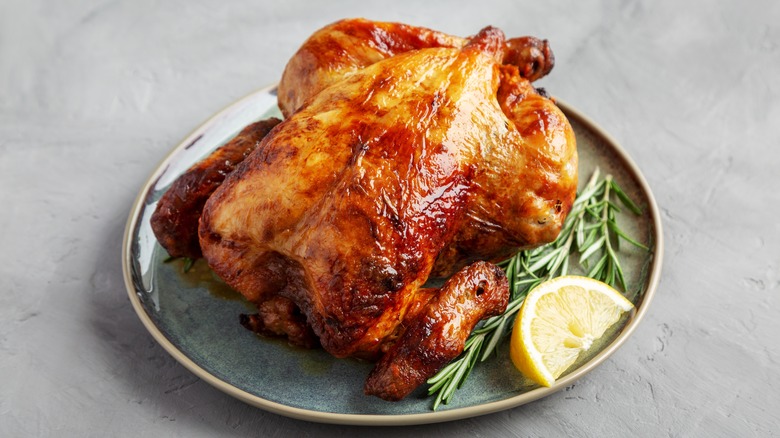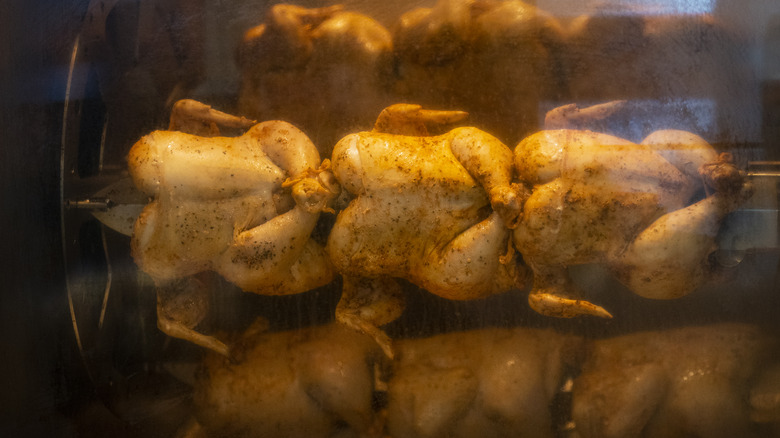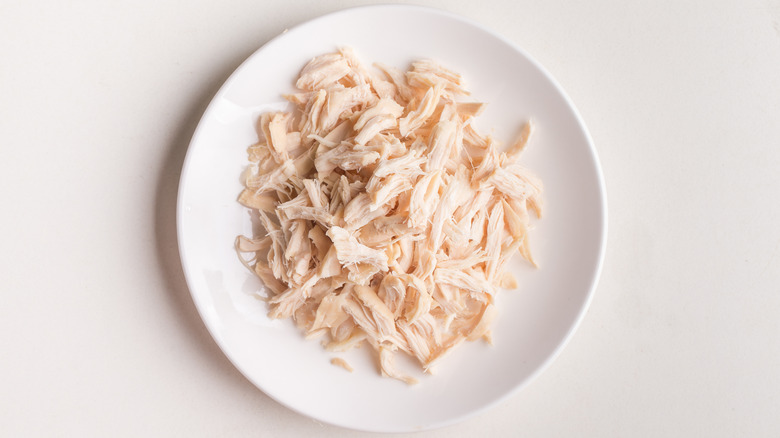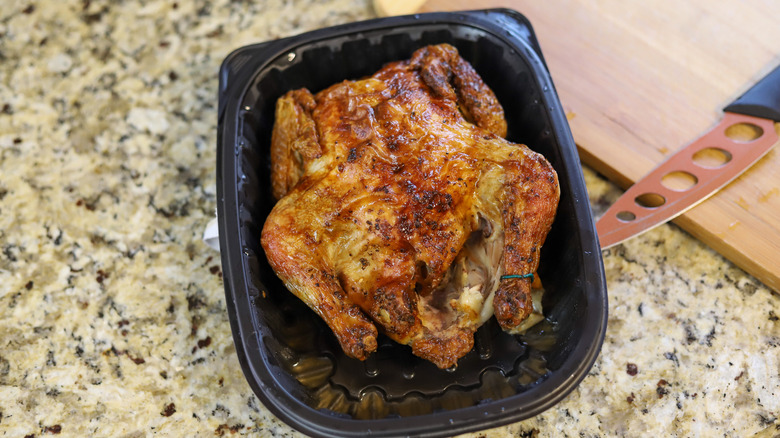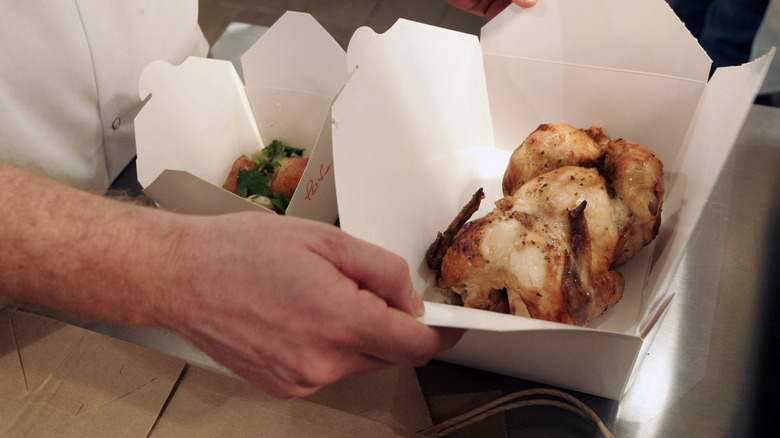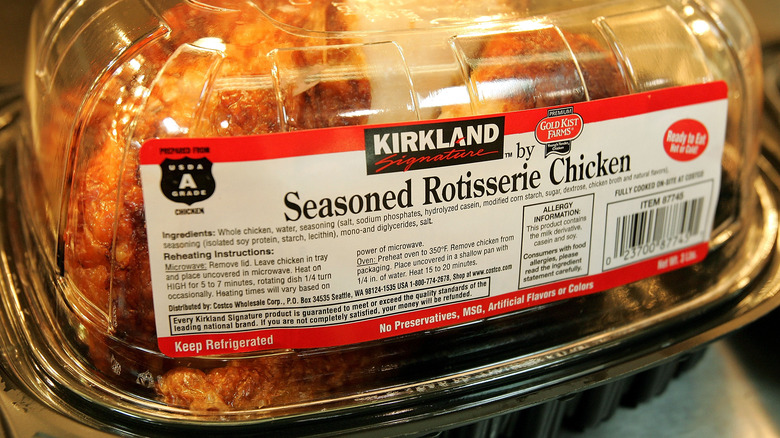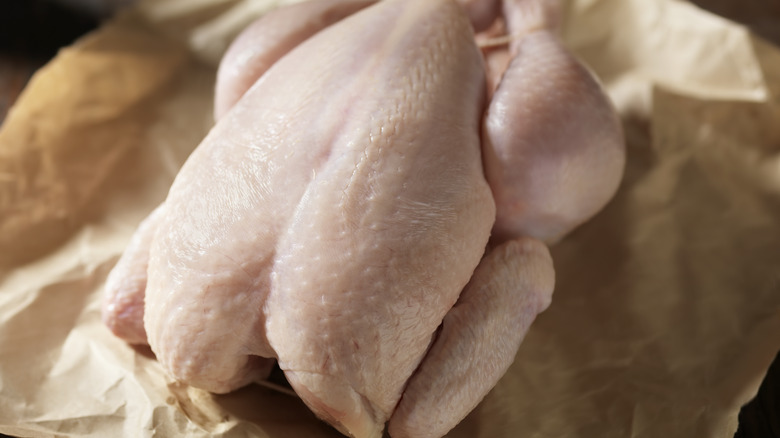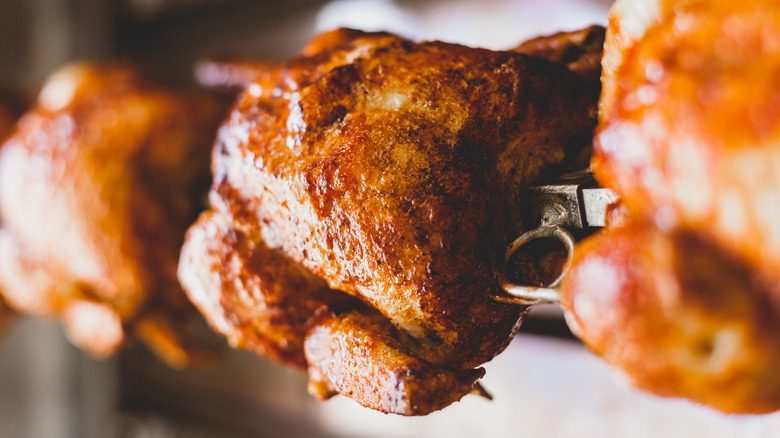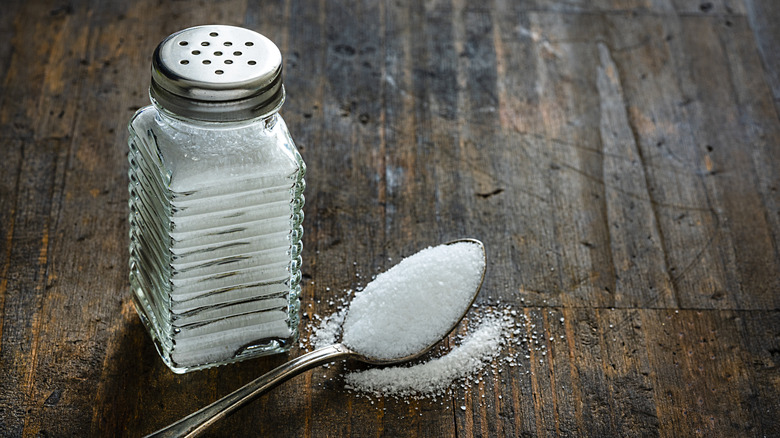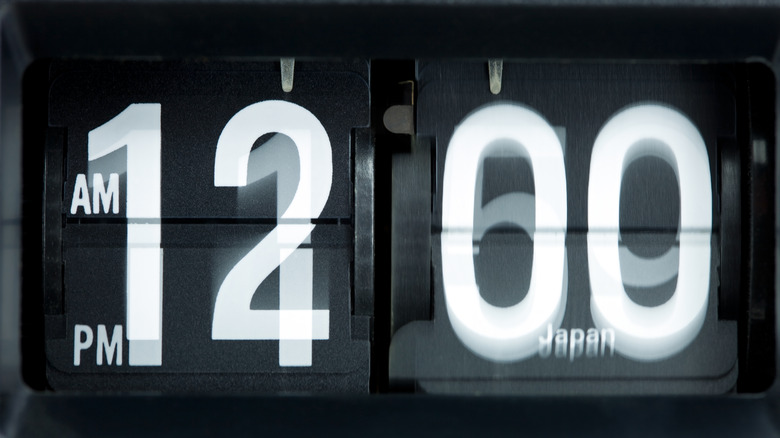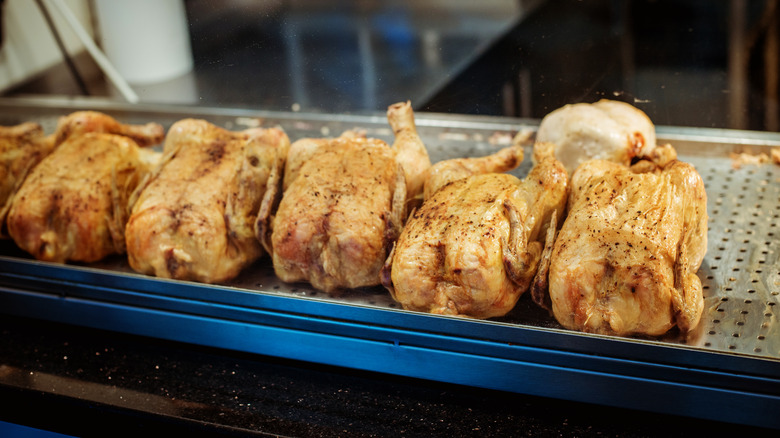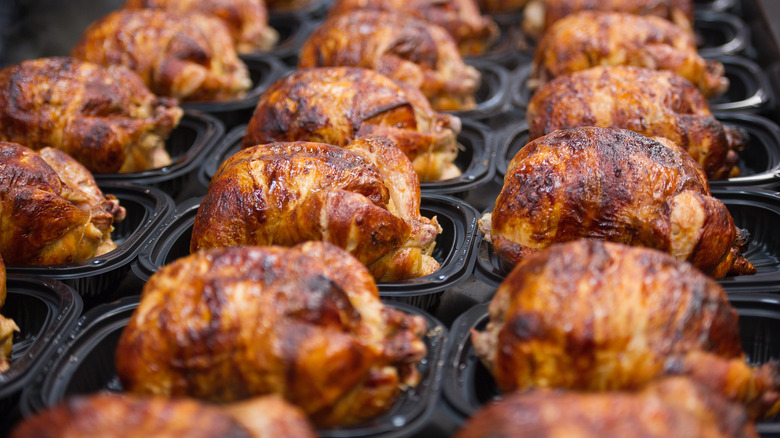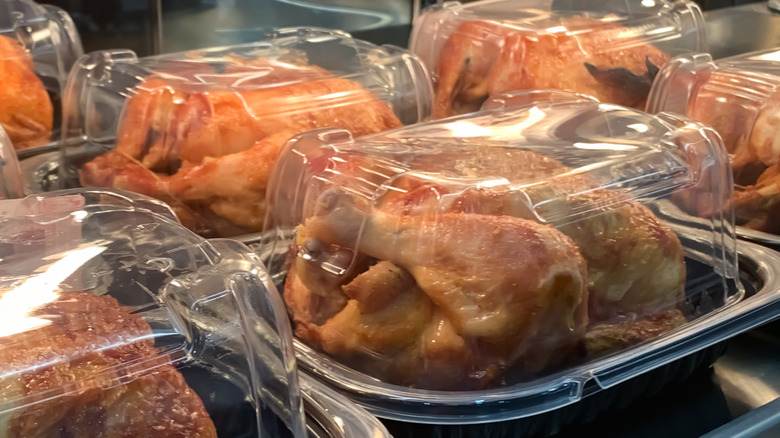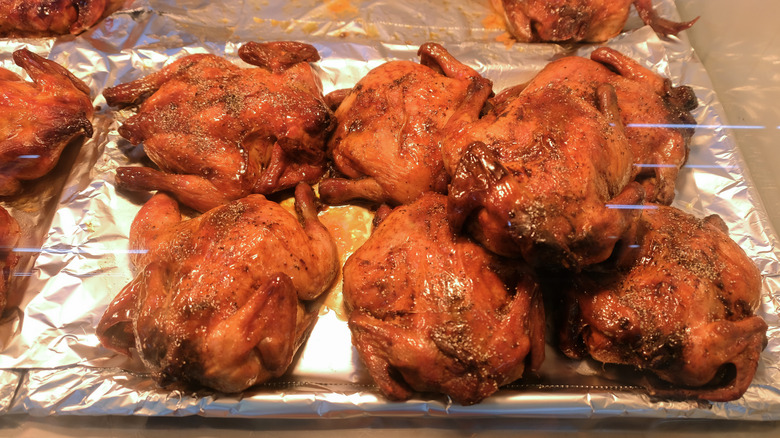14 Rotisserie Chicken Myths You Should Stop Buying Into
There are few meat options out there that are as convenient, or as tasty, as good old rotisserie chicken. This crowd-pleasing protein has only been a staple in supermarkets since the mid-1980s, but with its ubiquity, it feels as though it's been around for way longer. These days, virtually every mainstream supermarket has a rotisserie chicken section, with the granddaddy of them all, Costco, selling over 100 million of them per year.
We can understand why there's such high demand for these ready-to-go options, too. Rotisserie chickens are highly affordable food items that cut out the hours-long work of roasting a chicken at home, and give you immediate access to warm, delicious meat. They're the perfect take-home option for a speedy dinner, and leftover rotisserie chicken can be used in a nearly infinite amount of recipes, from chicken pot pie to Caesar salad.
Interestingly, though, for a food that's so popular, there's still a lot of misinformation about rotisserie chickens flying around. Certain myths are commonplace, with questions about their origins, their freshness, and their ingredients being asked routinely. These myths are made even more prevalent by the fact that these chickens are ready-cooked and often have limited nutritional information on their labels, meaning we have less knowledge about how they're made. Never fear, though — we decided it was high time to clear up a few facts about this evergreen supermarket staple.
1. Myth: Rotisserie chicken is the same as roast chicken
On the surface of things, rotisserie chickens seem virtually indistinguishable from regular roast chickens, to the point where you might be wondering what the point is of buying them in the first place if you can just make one at home. Try to make a rotisserie chicken in your oven, though, and you'll likely be disappointed.
Rotisserie chickens are cooked via a completely different method, with a rotating motion being the key to their all-over color and uniform flavor. As revealed in a YouTube video posted by a Walmart employee, supermarket rotisserie chickens are first loaded into a massive oven with various rotating racks. The racks then constantly rotate as the chicken is blasted with dry heat from all sides, giving it an even cook.
While the dry heat they're cooked in is similar to the method for a standard roast chicken, the motion here makes all the difference. As the chicken can brown on its bottom side, it develops even more flavor and gains a crispy surface on every part of its skin. With roast chicken, conversely, the underside is usually pretty pale and flabby, with fat pooling in your pan.
2. Myth: You can't freeze a rotisserie chicken
There's a lot of tentativeness around freezing rotisserie chicken, which we can understand. As you buy the meat pre-cooked, there's a sense that freezing it might somehow ruin its freshness, and when you defrost it, it may not be as tasty. However, this couldn't be further from the truth. You can absolutely freeze rotisserie chicken, and when portioned up correctly doing so can supply you with immediate access to cooked protein whenever you need it.
To freeze rotisserie chicken properly, though, there are a few steps that it's wise to follow. It's best to shred the chicken fully when it's warm, removing any bones and pieces of gristle. Although you can slice it into chunks, shredding it is usually the best way to get every piece of meat off the carcass, and allows it to defrost quickly.
You should also always make sure your chicken is completely cool before you place it in your freezer bags, to avoid generating any condensation. Make sure you remove as much air as possible from your containers and label them with the date you froze the chicken. When kept at a consistent temperature with limited access to air, frozen rotisserie chicken will stay fresh and tasty for around three months.
3. Myth: Rotisserie chicken should always be shredded when it's cold
Somewhere down the line, an idea developed that it was always better to shred rotisserie chicken once it's cooled down. While that may be slightly more comfortable for your hands, it will also result in you not being able to fully strip your chicken carcass from all of its meat. Warm rotisserie chicken is way easier to shred than a cold chicken, as when the meat is still warm it's way more pliable and soft. The chicken will also be easier to join or pull apart when it's warmer, meaning you can get into those nooks and crannies with more ease.
While you can use your hands to shred a rotisserie chicken (provided that they're totally clean, of course), it's a little more pleasant to use a pair of forks. Place your chicken on a cutting board, spear it with one of your forks, and use the other one to gently pull strips of chicken off, piling them up on one side. To make things even easier, you can also employ your hand mixer. Just put your chicken pieces in your mixing bowl, removing any bones first, and then switch your machine on, allowing it to whizz for around a minute. The best part about this method is you can switch it off at exactly your preferred consistency.
4. Myth: Reheated rotisserie chicken is always dry
It's pretty much guaranteed that your rotisserie chicken will be juicy and plump when you get it home from the store. What about if it's been sitting out for a while, though? There's an assumption that reheating your rotisserie chicken will somehow diminish its quality, reducing it to a dry, grainy shadow of its former self. Luckily, that doesn't need to be the case, and there are several ways to reheat this meat that keep it as moist as it was when it was first cooked.
Your oven, microwave, and air fryer can all be used to reheat rotisserie chicken. If you're using your oven, adding extra moisture is essential. Place your rotisserie chicken in a 350-degree Fahrenheit oven inside a roasting tin, and pour a cup of chicken broth into the tin with it. This broth will help to steam the chicken as it warms up, permeating its flesh and flooding its juiciness. In your microwave, you can regain this moisture by blasting it with a moist paper towel laid over the top.
If reheating in your air fryer, the good news is that you don't need to add any additional moisture — because the chicken reheats so quickly, it will retain its internal fluids and not dry out. If you like, you can also reheat your chicken on the stovetop by stir-frying it in a hot skillet. We'd only do this if you've already shredded it, though.
5. Myth: Rotisserie chicken is always pricier than uncooked chicken
Although rotisserie chickens are notoriously cheap, there are still some people out there who question exactly how cheap they are. After all, if they've already been cooked, surely you pay top dollar for the extra labor charges, right? Not necessarily. Rotisserie chicken is often much cheaper than raw chicken, despite being more convenient.
The reason for this, though, isn't rocket science — it's often a simple matter of price versus quantity. Generally, rotisserie chickens are much smaller than standard supermarket chickens. While your average raw chicken might weigh in at around 1.6 to 1.8 kilograms, many rotisserie chickens are usually several hundred grams smaller, with some weighing barely a kilo.
This smaller size allows them to cook more evenly and is generally the result of being supplied via a different chain than the regular raw chickens on the shelves. Interestingly, sometimes this separate chain allows supermarkets, like Costco, to offer same-size rotisserie chickens more cheaply than its raw items, as they control the supply of these chickens directly. More often than not, however, you're likely just paying less because the amount of meat itself is smaller.
6. Myth: Rotisserie chicken is made from meat that's about to expire
One of the most pervasive myths about rotisserie chickens is that they're somehow less fresh than the raw options available in-store and that supermarkets just decant their old stock into their rotisserie ovens. This can sometimes be used as an explanation for why they're so cheap. However, this is far from the true story. "Most stores buy the broiler chickens [used to make rotisserie chickens] completely separately from the fresh whole chickens they sell in the meat department," says 210 Analytics founder Anne-Marie Roerink, per Consumer Reports. You can usually tell the difference due to their weight, as rotisserie chickens are usually much smaller than even the tiniest raw option.
Besides, even if rotisserie chickens were made from almost-expired meat, that wouldn't mean that they're inedible. The expiry date on meat usually refers to the day it needs to be cooked by. As such, if your rotisserie chicken was cooked that day, it would still be safe to eat for roughly three days — provided the meat used hadn't gone bad, of course. Luckily, though, you can rest assured that your rotisserie chicken was likely fresh in the first place.
7. Myth: Pink meat in your chicken means that it wasn't cooked properly
When you haven't cooked meat yourself, it's easy to get a little squeamish about its doneness — especially around poultry, which can be somewhat more risky to eat when underdone than beef. So if you see some pinkness in your rotisserie chicken, the standard assumption about it is that it was undercooked by the supermarket, and therefore unsafe.
That isn't entirely true, however. Chicken can have slightly pink flesh on its insides for several reasons, none of them because they haven't been heated through. The first reason is due to a chemical change that occurs when the oven gases react with the hemoglobin in the chicken's meat tissues, which creates a pink tone throughout. This is more likely to happen if your chicken is especially lean or has incomplete fat coverage, or if the chicken's skin is thinner.
If your chicken has been fed with preservatives like nitrates or nitrites, which are provided via its feed, this can also create a lightly pink coloring inside. This pinkness can also occur from the inside out, as myoglobin from the chicken's bones seeps into the flesh. You should also feel safe in the knowledge that most supermarket rotisserie chickens are produced with fairly rigorous processes to reduce the likelihood of food poisoning. So, unless your instinct is saying that something's seriously wrong, it's probably best not to worry.
8. Myth: Rotisserie chicken is always a healthy option
Chicken is renowned for its lean protein, and is a firm favorite of fitness enthusiasts and healthy eating gurus alike. So surely that rotisserie chicken is likely to offer that same, cozy glow of wholesomeness... right? Not quite. Unfortunately, many rotisserie chickens are sky-high in sodium, and a "3-ounce serving [the size of a deck of cards] of rotisserie chicken could have more than 600 milligrams of sodium," warns registered dietitian nutritionist Bonnie Taub-Dix, via Today. It's worth remembering that's over 25% of your daily value for sodium in a tiny amount of food.
Much of a rotisserie chicken's sodium value comes from its production process, which sees many types injected with a salty solution. This solution, which can also contain other flavorings or preservatives, is intended to give it a taste boost and keep it juicy, but it also spikes its sodium content. This can be exacerbated even more if the chicken is then covered with a seasoning blend which, you guessed it, contains sodium. The skin of a rotisserie chicken can often be the saltiest part (which is usually why it's the tastiest part, too). If you're looking to reduce your sodium intake, removing the skin can be a good place to start — but you should also seek out nutritional information wherever possible on your chosen chicken.
9. Myth: The best rotisserie chicken is available in the morning
As the saying often goes, the early bird gets the rotisserie chicken (okay, it doesn't, but you get what we're doing here). Not all sayings are true, however – and the myth that you need to get up at the crack of dawn to get a fresh rotisserie bird is false. Rotisserie chickens aren't cooked in one go in the morning and left to sit under a heat lamp all day. Instead, they're generally cooked throughout the working day, starting at around eight A.M. until the early evening. These chickens are usually cooked in several-hour windows to ensure a steady stream of fresh meat. Any leftovers are usually then repurposed for other in-house deli meat items.
You may be better off waiting until the evening to get your rotisserie chicken. Perhaps because demand and footfall tend to be highest in the after-work hours, many supermarkets wait until later in the day to cook their best selection. As systems and supplies can vary considerably from store to store, though, we would always recommend double-checking with someone in your supermarket about when the chickens tend to be restocked or cooked.
10. Myth: Your rotisserie chicken is prepared in-house
It might be somewhat strange to think that the rotisserie chicken you just bought was plucked, prepared, and cooked by the very teenager who sold it to you. The thing is, though, most of the preparation of that chicken was done before it even arrived at the supermarket. Before they're cooked, rotisserie chicken carcasses go through a factory process, where they're basted and seasoned on their outsides. They also sometimes receive a treatment inside, by being injected with a saline solution that can contain other seasonings.
This saline solution can help to keep them juicy, and it also makes them plumper and heavier. Some factories will also load the chickens onto spits, reducing the workload when they arrive at the supermarket. Then, when they're in-store, all the staff have to do is load them into the oven to cook and check their temperature when done, before placing them onto the heat racks. While you may not love the amount of processing that your chicken undergoes, you can rest assured that each one is prepared with uniformity, guaranteeing flavor in whichever one you opt for.
11. Myth: Picking free-range or natural rotisserie chicken is better
We all want to eat quality meat that's been well-reared. With rotisserie chickens, whether that's what we're getting can be somewhat of a question mark. As the meat is already cooked, it can be difficult to assess what kind of standards it's been produced to, and the comforting labels that can be on raw chicken packets are often missing here. This is why it's probably pretty comforting to think that the words "free-range" or "natural" on your rotisserie chicken means that it's somehow been made to more ethical standards.
However, those terms don't indicate that much. Although they sound good, calling a chicken product "free-range" or "natural" doesn't mean that it's been reared under better welfare standards, had more indoor space, had access to natural light, or has been produced without antibiotics. While free-range chickens have access to outdoor space, there's no clear definition about how much, or what kind of space they have. "Free-range" and "natural" products aren't also subject to the same audit standards as other animal welfare certifications are.
Instead of looking for these terms, you should always try and buy chicken that's labeled as "certified humane," "animal welfare approved," or as part of the "global animal partnership." These will indicate the best standards possible for your meat.
12. Myth: Rotisserie chicken always contains strange additives
What's in your rotisserie chicken? It might be a question you've asked yourself recently, and we wouldn't blame you — these things may be ready-cooked and delicious, but all that flavor has to come from somewhere. Thankfully, though, the idea that every rotisserie chicken out there is pumped full of additives is a myth, and options from retailers like Kroger and Whole Foods tend to be refreshingly natural. Kroger's chickens only contain chicken, water, and sea salt, and have a low sodium level overall, with just 40 milligrams per serving.
Whole Foods' chickens, on the other hand, aren't subject to the same saline injection that other options are and are just seasoned on their outsides. Having said this, its "classic" chicken is still relatively high in sodium, due to its exterior seasoning blend. Other rotisserie chicken options may not give you the same grace when it comes to additives, however. Some chickens can be injected with or coated with additives like carrageenan or "natural flavors," which sound great but have a pretty hazy definition. If you can, it's always worthwhile digging a little deeper with your supermarket to see what they're putting in your chicken.
13. Myth: All rotisserie chicken basically tastes the same
Rotisserie chicken is pretty reliable no matter where you get it from, and it's unlikely to surprise you that much in terms of flavor. The idea that it's the same everywhere, though, is just not true. Supermarkets can season their rotisserie chickens with a wide range of different flavors, and failing to check which one you're grabbing may leave it incompatible with your chosen dish. At Walmart, for instance, it has a regular and a lemon pepper flavor, both of which taste pretty different from each other. Sprouts Farmer's Market, meanwhile, uses an herb seasoning blend on its chickens, and other supermarkets may use barbecue or garlic flavorings to brighten things up.
It's useful to remember that rotisserie chickens can also vary considerably in their quality, and some can be much tastier than others. Walmart's rotisserie chickens may be widely available, but they can sometimes tend to be overcooked. Kroger chickens, meanwhile, can be lacking in actual meat and be somewhat skinnier. On the flip side, Costco's rotisserie chickens tend to be tasty every single time, which is probably why they're so darn popular.
14. Myth: Rotisserie chicken is always safe
Now look, we don't mean to scare anyone here: The vast majority of the time, rotisserie chicken is produced and sold under sanitary standards. It's a mistake, though, to assume that every single rotisserie chicken in the country, in every single store, is safe. The unfortunate fact of the matter is that sometimes, rotisserie chickens can be left to sit out for too long in heated displays that aren't hot enough to stop them from developing bacteria, or in displays that have broken thermometers, as an investigation by Fox 11 indicates.
Luckily, there are a few things to do when buying your rotisserie chicken to ensure it's as safe as can be. "Go for the ones that are hotter as opposed to the ones that are cooler, because you know this one has been receiving adequate temperature," suggests food safety consultant Jeff Nelken. It might be a good idea to try and pick the chickens that are sitting closest to the heat lamps to ensure this. When you touch your chicken, too, make sure that it feels hot. Your chicken should also not look slimy or have an unpleasant smell emanating from it. If you have any doubts whatsoever about the safety of the chicken on display, leave it exactly where it is, and buy one elsewhere.
